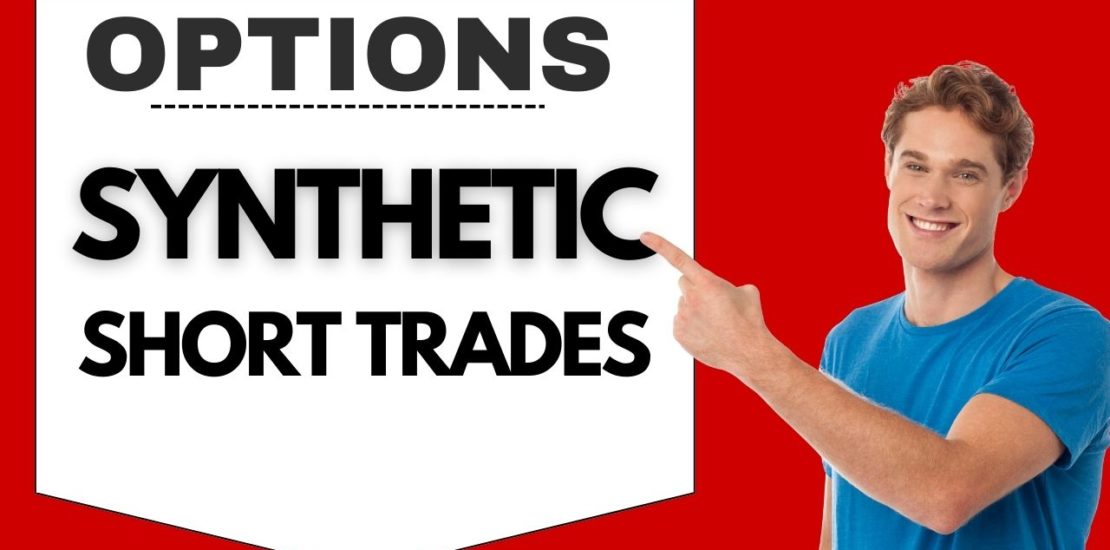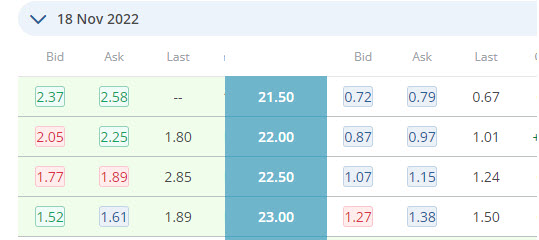- December 5, 2022
- Posted by: Shane Daly
- Category: Trading Article

A short synthetic stock position is created when a trader buys an ATM put option and sells an ATM call option at the same time. This is a bearish position on a stock without needing to own or borrow the stock to trade.
One reason we like to trade options is that we get to take advantage of the movement of expensive stocks without the capital requirement. For a fraction of the amount of buying or selling a stock, we can make money (some strategies up to 5 ways to make money) with the same price movements.
What Are The Risks Of A Synthetic Position?
While there are many benefits to creating synthetic positions, there are also some risks involved and risk is the most important thing to know.
First, because you’re using leverage (options contracts typically control 100 shares of the underlying security), your losses can be magnified if the trade doesn’t go your way.
Second, there’s always the risk that one side of your trade gets assigned (meaning you have to buy or sell shares of an underlying security at the strike price) before you’re able to close out your position. This can happen if there’s sudden news that impacts one side of your trade more than the other.
In the case of our short, the risk potential is unlimited if that underlying instrument continues to rally. A losing trade occurs when the price of the underlying asset is greater than the strike price of the short call plus the premium we received.
What Are The Positives Of A Synthetic Position?
These allow traders who don’t have enough money to buy shares outright still gain exposure to that security. Trading options does not require the same capital as would trading the actual underlying.
They can allow investors to take advantage of different market conditions by being able to profit from both rising and falling markets. With some of the options strategies we use, our risk is fully defined.
The profit potential is great on these trades because a stock can go to zero. Remember, you bought a put option that gives you the right to sell that stock at the strike price. We achieve our profit when the price of the underlying asset is less than the strike price of the put option plus the net premium you received when you sold the call option.
When Are We Breakeven?
Knowing when you are at breakeven is essential to the proper management of your trade. To calculate your breakeven point: Strike Price of Long Put + Net Premium Received.
For example, if you bought a $50 put for $2 and sold a $50 call for $1, your breakeven point is at $51 ($50 strike + $1 premium received for selling the call).
As with any trade, the key to success is proper risk management. You should always have a plan in place before you consider pushing the buttons.
Synthetic Short Trade Example
Let’s imagine that I wanted to short TRIP and is currently trading at $23.31. Keeping in mind that each options contract is 100 shares, I would need about $23000.00 to short 100 shares of stock. That is very capital-intensive.

Using a synthetic short trade and the strike price of $23.00, I will buy an ATM put option for $1.38 and sell an ATM call option for $1.52.
The put option will cost me: 1.38 x 100 = $138.00
Selling the call option would give me a credit of: 1.52 x 100 = $152.00
My net premium is 152.00 – 138.00 = $14.00
On the expiration date, if TRIP is trading at $18, the call option will be worthless as the buyer of that call would, in most cases, not exercise. The put expires in the money and would be approx. $500.00 ($5/share decline x 100) and the net premium received ($14.00), your gross profit would be around $514.00.
This is fairly close to what you could receive if you shorted the actual stock with much more required capital.
On the flip side, if TRIP rallies to $28.00, your put would expire worthless on expiration day but the call you sold in in the money with an intrinsic value of $500.00. Your loss would be $500 – net premium received of $14.00 = $486.00.
Quick FAQ
A short synthetic stock position is created when a trader buys an ATM put option and sells an ATM call option at the same time.
This is a bearish position on a stock without needing to own or borrow the stock to trade.
One reason we like to trade options is that we get to take advantage of the movement of expensive stocks without the capital requirement.
While there are many benefits to creating synthetic positions, there are also some risks involved and risk is the most important thing to know.
First, because you’re using leverage (options contracts typically control 100 shares of the underlying security), your losses can be magnified if the trade doesn’t go your way.
Second, there’s always the risk that one side of your trade gets assigned meaning you have to buy or sell shares of an underlying security at the strike price of the option.
This is just one of the many ways you can trade options.
Download your FREE Options Guide to learn even more ways to profit
2 Comments
Comments are closed.

What is a Capital Requirement? Can I buy a ATM put and sell a ATM call at the same time? There are risks and leverage with synthetic positions!
I am really scared to consider pushing buttons!!! And, I cannot call or put credit spreads with options. I am over 80 years old and I just made a
mistake way back in October and I need more help all the time. Please help me as I am trying to do the right thing. I look at all of Netpicks and
I really try but I just can’t understand it all. Patricia Ann Rathbun Long
Hi Patricia –
Brokers will have different types of account requirements for these kinds of trades.
Best thing is to reach out to our Options specialist Mike. He can be reached at mike@netpicks.com